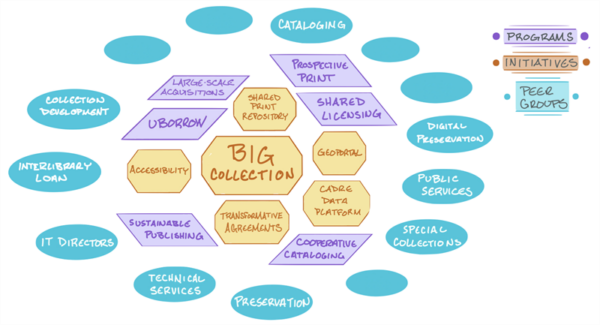
The Big Ten Academic Alliance (BTAA) has a goal to cooperatively steward the collections of its member libraries in a project called the Big Collection. These libraries hold upwards of 164 million volumes and are together one of the largest physical collections in North America.
Moving towards the Big Collection, the BTAA is working to:
- Tackle technical and policy changes to create a networked environment for users by implementing policies and technology that ensure everyone can smoothly access the same content, find what they need easily, and get it quickly.
- Expand existing programs and create tools to coordinate the acquisition of new books and digital resources, leveraging each school’s collections and the alliance’s buying power.
- Ensure the collection will be preserved and accessible by setting policies for keeping enough copies and investing in preserving and digitizing them so that people can still access them in the future.
- Foster a culture of deep collaboration and interdependence across member libraries.
Emily Campbell, U-M librarian and director of document delivery, shares, “One aspect of this Big Collection that is already very functional is interlibrary loan and the movement of material. In the past decade and a half, we have chosen to focus on our consortial relationships to save on the cost of borrowing material. We don’t charge each other in the BTAA, and we promise a level of service to each other that we don’t to other schools, such as extended loan terms.”
One of the complications is that each school has its own identity, as well as local obligations to its campus. It is more challenging to create systems and processes that meet a variety of institutional approaches. For example, some schools might be fine having everything in the Big Collection visible in their catalog, while other schools have an obligation to highlight their own material. Another complicating factor is that some schools want to emphasize their statewide library systems and would like patrons to see and access those resources before delving into the Big Collection. The struggle is: How do you create a discovery layer that meets all of those needs?
Cross-school authentication is another challenge. Different institutions have different authentication schemes. Does the Big Collection support different schemes for different schools, or does a single standard need to be decided on and implemented?
The Big Ten Academic Alliance has started the multi-year process to bring it to fruition, and it’s clear that big questions and challenges are ahead for the Big Collection. The BTAA has made a significant commitment to the concept of a shared, multi-institutional collection.
